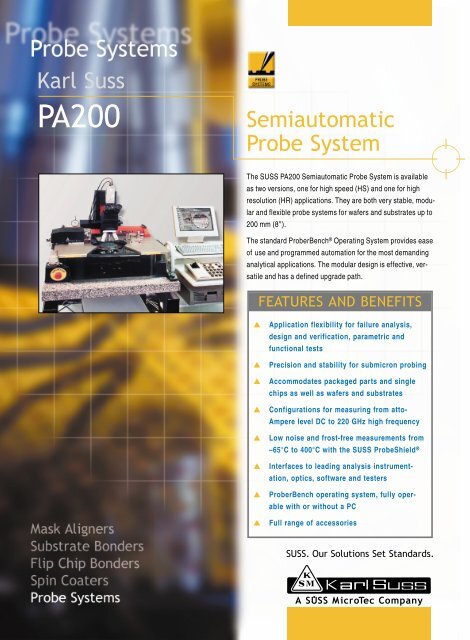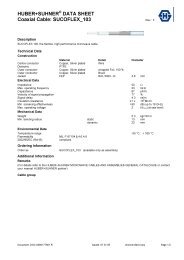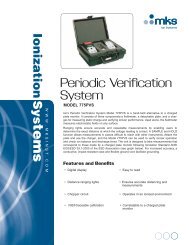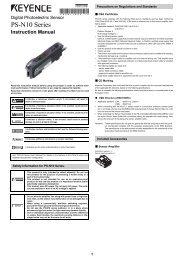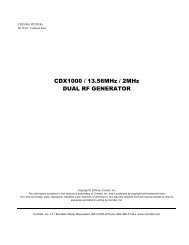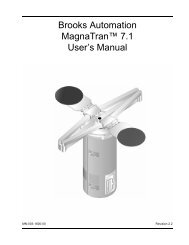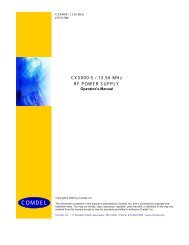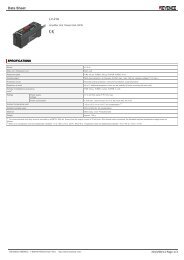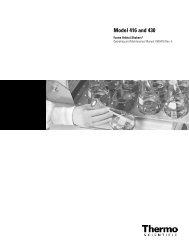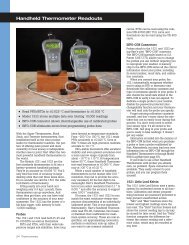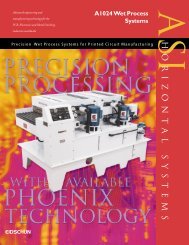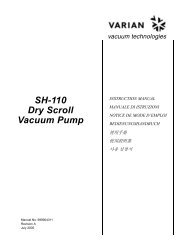Karl Suss Semiautomatic Probe System - CERN
Karl Suss Semiautomatic Probe System - CERN
Karl Suss Semiautomatic Probe System - CERN
Create successful ePaper yourself
Turn your PDF publications into a flip-book with our unique Google optimized e-Paper software.
<strong>Karl</strong> <strong>Suss</strong><br />
PA200<br />
<strong>Semiautomatic</strong><br />
<strong>Probe</strong> <strong>System</strong><br />
The SUSS PA200 <strong>Semiautomatic</strong> <strong>Probe</strong> <strong>System</strong> is available<br />
as two versions, one for high speed (HS) and one for high<br />
resolution (HR) applications. They are both very stable, modular<br />
and flexible probe systems for wafers and substrates up to<br />
200 mm (8).<br />
The standard <strong>Probe</strong>rBench ® Operating <strong>System</strong> provides ease<br />
of use and programmed automation for the most demanding<br />
analytical applications. The modular design is effective, versatile<br />
and has a defined upgrade path.<br />
FEATURES AND BENEFITS<br />
▲<br />
▲<br />
▲<br />
▲<br />
▲<br />
▲<br />
▲<br />
▲<br />
Application flexibility for failure analysis,<br />
design and verification, parametric and<br />
functional tests<br />
Precision and stability for submicron probing<br />
Accommodates packaged parts and single<br />
chips as well as wafers and substrates<br />
Configurations for measuring from atto-<br />
Ampere level DC to 220 GHz high frequency<br />
Low noise and frost-free measurements from<br />
–65°C to 400°C with the SUSS <strong>Probe</strong>Shield ®<br />
Interfaces to leading analysis instrumentation,<br />
optics, software and testers<br />
<strong>Probe</strong>rBench operating system, fully operable<br />
with or without a PC<br />
Full range of accessories<br />
SUSS. Our Solutions Set Standards.<br />
A SU SS MicroTec Company
Challenges ...<br />
Analytical DC test High frequency test Automated MCM test<br />
Improve your Yield<br />
The value of failure analysis increases as its impact on customer<br />
satisfaction, yield, quality and reliability is realized. This<br />
reliance on failure analysis, combined with greater circuit complexity<br />
and smaller structures, enhances the role of semiautomatic<br />
probers.<br />
Versatility<br />
Where a failure analysis lab once handled only packaged parts<br />
or wafers, it is now routinely asked to analyze a device at any<br />
stage of its lifecycle: from the wafer fab to an end user return.<br />
A prober must quickly adapt to handle products from wafers<br />
and single chips to packaged parts.<br />
Return on Investment<br />
The cost of failure analysis will grow, particularly for leading<br />
edge technology, necessitating higher equipment utilization<br />
and demanding a better return on investment.<br />
Interfacing<br />
Failure analysis, typically characterized as a hands-on procedure,<br />
manually placing probes and adjusting the device, has<br />
progressed to programmed automation for acquiring statistically<br />
relevant data across a wafer.<br />
A prober must interface to an array of hardware and software<br />
instruments, including emission microscopes, laser cutters,<br />
data acquisition, CAD navigation software and other test<br />
equipment.<br />
Precision<br />
With the increase in the number of I/O pads and the decrease<br />
in feature size, a prober is expected to provide the rigidity<br />
required to use production probecards, as well as accuracy for<br />
in-circuit stepping routines. Simultaneous use of probecard<br />
and <strong>Probe</strong>Heads to contact submicron gates is required.<br />
Low Signal Measurements<br />
The quality of all low-signal and sensitive measurements is<br />
dependent on the noise floor of the measurement system. All<br />
low signal measurement concerns were taken into consideration<br />
when designing SUSS probing equipment. This gives optimal<br />
noise reduction with superior performance capabilities. The<br />
PA200 system with a <strong>Probe</strong>Shield ® is optimally configured for<br />
demanding low signal and frostfree low temperature testing.<br />
The unique design of the SUSS <strong>Probe</strong>Shield guarantees a<br />
light-tight, gas tight, electromagnetic shielded, and ultra low<br />
noise environment while testing. It is ideal for ultra low signal<br />
measurements in the AttoAmp, FemtoFarad and MicroVolt<br />
range.<br />
2<br />
OUR SOLUTIONS SET STANDARDS
... and Solutions<br />
Ease of Use<br />
Lab environments also influence<br />
the design of semiautomatic probers.<br />
In open labs with dozens of users,<br />
the prober must be simple and easy<br />
to operate. On the other hand, a prober<br />
with a dedicated user should also<br />
maximize performance.<br />
The SUSS PA200 <strong>Semiautomatic</strong><br />
<strong>Probe</strong> <strong>System</strong> meets these challenges<br />
through innovative design, precision<br />
and reliability.<br />
A Graphical User Interface provided<br />
by the renowned SUSS<br />
<strong>Probe</strong>rBench software makes<br />
the PA200 a fully functional,<br />
flexible yet simple tool where<br />
various set-ups can be stored<br />
for individual tasks.<br />
Laser Cutting<br />
Precise Mechanics<br />
The SUSS PA200 <strong>Semiautomatic</strong> <strong>Probe</strong> <strong>System</strong> relies on a<br />
cast base frame and massively machined components to provide<br />
an extremely stable probing environment as well as software<br />
compensation. Precise resolution and accuracy results<br />
from using a ball-screw drive and glass scales in closed-loop<br />
positioning.<br />
Modular Design<br />
Modular construction provides application flexibility and cost<br />
effectiveness. Microscope mounts include fixed, manual and<br />
programmable, as well as programmable focus and magnification.<br />
<strong>Probe</strong>Head platens are available for DC, HF and specialized<br />
applications, with fixed or manual movement.<br />
The standard chuck secures single chips to 8 wafers;<br />
optional chucks handle fragile III-V compound wafers and<br />
rectangular substrates.<br />
A typical CAD Navigation set-up<br />
Adaptation to the height differences between wafers and<br />
packaged parts is accomplished by the chuck and platen<br />
having 30/15 (HR/HS) and 20 mm of travel respectively, for<br />
approx. 50 mm (2) of working clearance. DUT boards are<br />
secured by vacuum to the standard wafer chuck, so chuck<br />
planarity is not affected.<br />
User-Friendly<br />
The <strong>Probe</strong>rBench ® Operating <strong>System</strong> is a powerful multitasking<br />
system with joystick controller, graphical and remote<br />
interfaces. The Windows ® based graphical interface includes<br />
Navigator on-screen joystick and setup, TableView spreadsheet,<br />
graphical WaferMap and optical VideoTracker navigation<br />
and data acquisition modules. Standard remote interfaces<br />
are IEEE488 and RS232. The prober is fully operable<br />
without a PC.<br />
3
Application flexibility<br />
data acquisition/analysis software. All <strong>Probe</strong>Heads can<br />
be simultaneously used with a probecard and with active<br />
probes. SUSS stability allows the smallest features to be<br />
easily probed at the highest magnifications, especially<br />
when used with the SUSS MFI <strong>Probe</strong> for scanning and<br />
probing below 0.2 µm.<br />
High Frequency<br />
PA200 with <strong>Probe</strong>Shield ® EMC for low signal and low temperature probing<br />
Application flexibility is defined by the diversity of applications,<br />
as well as the specific requirements of each. There are<br />
many aspects to consider: Measurement type and integrity,<br />
integration into a test system and how the user interacts<br />
with the system as well as mechanical stability and accuracy.<br />
SUSS addresses these issues with a modular or customer<br />
specific design and with our wide range of accessories.<br />
DC Parameter testing<br />
For DC parametrics, the software can be configured as a<br />
simple, easy to use interface for scanning a wafer during<br />
fast step-and-repeat patterns. Hardware choices include<br />
high pin-count probecard adapters, triaxial probes, chucks<br />
(standard and thermal), and the SUSS <strong>Probe</strong>Shield ® for low<br />
current and capacitance measurements. The unique Quiet<br />
Mode removes power to all motors to reduce the noise floor.<br />
SUSS precision allows the reliable, automatic probing of transistors<br />
and the smaller pads of monitor chips.<br />
The SUSS PA200 has the stability for HF on-wafer probing<br />
without compromising flexibility. A complete range of accessories<br />
for probing up to 220 GHz is available and includes:<br />
<strong>Probe</strong>s, calibration substrates and software, positioners,<br />
chucks, cables and IC-CAP interfacing.<br />
Temperature Probing<br />
The SUSS <strong>Probe</strong>Shield also provides an innovative approach<br />
to probing down to –65°C. Frost-free low temperature probing<br />
requires that the air surrounding the cold chuck is pressurized,<br />
clean and dry. Just enough pressure is required to keep<br />
the ambient air out of the chamber. The air is dried so that its<br />
dew point is lower than the chuck temperature.<br />
For thermal low signal applications, SUSS supplies a range of<br />
low leakage thermal chucks up to 300°C.<br />
Failure Analysis<br />
For failure analysis mechanical versatility provides quick<br />
changeover between packaged parts and wafers. The<br />
<strong>Probe</strong>rBench operating system has been integrated with<br />
the most common failure analysis tools, including emission<br />
microscopes, CAD navigation software, laser cutters and<br />
4<br />
OUR SOLUTIONS SET STANDARDS<br />
PA200 high frequency application
The Design<br />
PH600<br />
Programmable<br />
<strong>Probe</strong>Head<br />
Microscope<br />
CCD Camera<br />
Microscope<br />
bridge<br />
Motorized<br />
focus<br />
PH150<br />
Analysis <strong>Probe</strong>Head<br />
Joystick<br />
controller<br />
<strong>Probe</strong>rBench<br />
User Interface<br />
SUSS PA200 <strong>Semiautomatic</strong> <strong>Probe</strong> <strong>System</strong><br />
The prober mechanics are based on a web-reinforced, aluminum<br />
casting for excellent rigidity and vibration damping.<br />
The wrap-around design places the stage and platen drives<br />
into, rather than on top of, the base further increasing stability.<br />
All surfaces are finished in cleanroom grade paint or are<br />
anodized.<br />
The X-Y stage is constructed of steel for temperature stability.<br />
Linear accuracy and torsional stiffness are enhanced<br />
with wide spaced bearings and the use of ground in place<br />
of the more typical rod and ball slides. A ball-screw drive is<br />
utilized which automatically compensates for wear and<br />
ensures the system will remain backlash-free. The DC servo<br />
closed loop positioning system uses linear encoders to<br />
read the actual stage position and to preclude leadscrew<br />
induced thermal errors. In addition to the superior mechanical<br />
design, two software compensation routines are used:<br />
linear and matrix. “Linear” adjusts positioning by an equal<br />
amount over the 200 mm travel range and can be used to<br />
correct thermal chuck induced wafer expansion/contraction.<br />
“Matrix” maps the stage throughout its travel for finer accuracy.<br />
Axes orthogonal error is also compensated. The Z and<br />
theta axes are DC servo closed loop driven.<br />
The microscope is supported by a cast<br />
aluminum bridge for stability at the highest<br />
magnifications. The bridge design allows<br />
rearward access for cable routing. The<br />
cantilevered load of a microscope is<br />
a design challenge addressed by using<br />
bearing ways. The programmable microscope<br />
movement closed loop DC servo<br />
drive provides 50 mm of travel. Software<br />
compensation is used, and is aligned to<br />
the chuck stage for parallel movement<br />
between the stages. Programmable focus,<br />
and magnification on some microscope<br />
models, is also available.<br />
The <strong>Probe</strong>Head Platen is the most versatile component of a<br />
prober. For DC applications the material is typically aluminum<br />
which is hard-coated for durability and uses vacuum holddown.<br />
High frequency applications require greater rigidity,<br />
therefore steel is used for magnetic, bolt-down and kinematic<br />
mounting. <strong>Probe</strong>card adapters are available for all platens.<br />
Although the platen can be mounted in a fixed position,<br />
a manual drive mechanism is more commonly used. The<br />
mechanism consists of four columns with ball-cage bearings<br />
providing an extremely stabile, linear and repeatable movement.<br />
The drive knob, conveniently located at the left front<br />
corner, provides a fine 400 µm contact/separation stroke,<br />
as well as 20 mm of coarse travel for adjusting to test<br />
fixturing and thermal chucks.<br />
The mechanics are controlled by the SUSS <strong>Probe</strong>rBench<br />
Operating <strong>System</strong> consisting of the drive electronics,<br />
joystick controller and Windows user interface. Interfacing<br />
flexibility is provided with an IEEE488 port in the electronics<br />
and an IEEE488 and an RS232 port in the PC. All ports can<br />
be used simultaneously. This is the same for all SUSS <strong>Probe</strong><br />
<strong>System</strong>s.<br />
5
Flexible and versatile<br />
Drive Electronics<br />
The drive electronics which use standard SUSS components<br />
are housed in a standard 619 cabinet. As a separate unit<br />
there is greater flexibility. Furthermore the mechanics are<br />
smaller and electrically quieter.<br />
All motorized prober functions are integrated at the electronics,<br />
so there are no additional boxes or controllers. In addition<br />
to the chuck and microscope stages, up to four <strong>Probe</strong>Heads<br />
and two contact sense cards can be accommodated.<br />
The system complies with leading guidelines, including SEMI<br />
S2-93, IEC 204-1 and EC-Low Voltage Directive (CE-Mark)<br />
and EN61010-1.<br />
<br />
<br />
<strong>Probe</strong>rBench within the SUSSCAL Calibration Software<br />
<br />
Joystick Controller<br />
The joystick controller is solidly constructed of stainless<br />
steel and uses rotary encoders for proportionally precise,<br />
uni- or bi-directional control. It is more than a simple joystick<br />
controller, providing full prober functionality via fixed and<br />
LED-defined programmable keys. Included are two-point<br />
theta alignment, setting index, home and contact, as well<br />
as go load and scope lift are provided.<br />
User Interface<br />
The Windows ® user interface consists of joystick, spreadsheet,<br />
graphical and video control modules.<br />
The Navigator on-screen joystick provides<br />
navigation by mouse and the entry of all setup<br />
parameters.<br />
TableView controls stage movement by coordinates,<br />
which are in spreadsheet format<br />
and are entered by recording the current position,<br />
keyboard, pasting and importing. Up to<br />
96 columns are available for test results,<br />
binning or comments.<br />
The graphical WaferMap can be used to<br />
quickly move to dies using coordinates or as<br />
part of an automated test routine and has subsite<br />
probing capability.<br />
VideoTracker conveniently displays a video<br />
image in a window of the PC monitor and has<br />
the ability to save the image to disk. Chuck, microscope and<br />
<strong>Probe</strong>Head positioning is as simple as clicking on the image.<br />
All setup parameters are contained in project files, whereas<br />
the data from the TableView and WaferMap modules is saved<br />
in ASCII-format files for easy transfer to and from other instruments.<br />
Temperature compensations are no longer necessary<br />
as seperate wafer maps with different temperature settings<br />
can be stored for the same project.<br />
6<br />
OUR SOLUTIONS SET STANDARDS<br />
This electronic rack, joystick controller and user interface<br />
combination is common to all SUSS programmable <strong>Probe</strong><br />
<strong>System</strong>s, thus reducing the learning curve and ensuring compatibility<br />
of instrument and software drivers.
The PA200 modular <strong>Probe</strong> <strong>System</strong><br />
Microscope stages<br />
Stage type Travel Resolution Access lift options Recommended microscope Application<br />
Programmable 5050 mm 0.25 µm Standard 80 mm pneumatic High magnification Internal die navigation<br />
or 130 mm motorized or stereo view and remote control<br />
Manual 5050 mm 40 mm/rev. Fixed, manual or High magnification Internal die<br />
pneumatic tilt-back<br />
or stereo view<br />
High resolution 5050 mm 0.25 mm/rev Fixed, manual High magnification Internal die and laser cutting<br />
manual<br />
or pneumatic tilt-back<br />
Adjustable 3030 mm Fixed Stereo view Minimal movement required<br />
Microscopes<br />
Microscope type Models available Application<br />
Stereo view Olympus SZ4045 Series, Leica M5-12 Series Pad probing and internal features down to 5 µm<br />
High magnification Mitutoyo FS-70 Series, A-Zoom Offers the most flexibility and options for features down to 0.5 µm<br />
w/out Eyepieces Optem HF applications and use with TV systems<br />
<strong>Probe</strong>Head platens<br />
Software interfaces<br />
PH Mounts<br />
Application<br />
Application<br />
Vendors<br />
Vacuum<br />
Most common, offers ease of use and flexibility<br />
CAD Navigation<br />
Knights Technology, Schlumberger, Raith<br />
Magnetic<br />
Mechanical<br />
Offers more rigidity than vacuum. Commonly used when<br />
magnetic base <strong>Probe</strong>Heads are already used<br />
Mechanical T-nut mount providing high rigidity<br />
Emission Microscopy<br />
Data Acquisition<br />
Hypervision, Hamamatsu, EDO Barnes<br />
Metrics ICV, NI LabView, Lab Windows/CVI,<br />
Keithley, TestPoint, Mosaid, Agilent VEE<br />
HF Universal<br />
Customized<br />
Offers vacuum, magnetic, bolt down and kinematic<br />
mounting. Kinematic requires additional kit<br />
Custom designs are available for specialized applications,<br />
such as testhead docking, substrates and MCM test<br />
Design and Modeling<br />
Programming<br />
Laser Cutting<br />
Thermal Chucks<br />
Agilent IC-CAP, Silvaco<br />
MS Visual Basic, C++, Delphi<br />
New Wave Research<br />
Temptronic, ERS, Trio Tech<br />
Accessories<br />
<strong>Probe</strong>s: Active, passive, HF, triaxial, coaxial, low impedance, Kelvin<br />
<strong>Probe</strong> tips: Tungsten, tungsten-carbide, palladium, copper shaft<br />
<strong>Probe</strong>cards: SUSS supports all major probecard manufacturers<br />
Manual <strong>Probe</strong>Heads: Contacting bond pads & internal nodes down to 1 µm<br />
Remote controlled <strong>Probe</strong>Heads: For submicron probing, programmable<br />
ShieldEnclosure SE1000: Light-tight or EM-shielded versions<br />
Laser cutter: Depassivating, cutting traces, trimming and blowing fuses<br />
Ultrasonic cutter: Depassivating brittle materials<br />
Utility . pumps: Vacuum, pressure or combinations<br />
Standard chucks: From 4 to 8 (100–200 mm), usually made of stainless<br />
steel<br />
Triaxial chucks: For low-signal measurements<br />
High . insulation chucks: Power device test, low capacitance demands<br />
Microwave chucks: Designed for brittle III-IV compounds and high measurement<br />
stability. Auxiliary chucks for calibration and burnishing substrates<br />
Thermal chucks: Adaptor kits for all hot chucks on the market available<br />
<strong>Probe</strong>Shield ® : Completly light-tight, gas-tight and EM-shielded design for lowsignal<br />
and frost-free low temperature probing<br />
Material handling: Provides system automation, as well as eliminates user<br />
handling, and possible damage to wafers<br />
Pattern recognition: Complete system automation for cassette-to-cassette<br />
operation, vision module<br />
Packaged device holders: Held down by vacuum on the chuck’s surface<br />
Fixtures and chuck accessories: Quickly manufactured to hold down substrates,<br />
provide alignment pins, or allow bottom side probing<br />
Chuck surfaces: Standard: stainless steel. Options: gold plated, Teflon<br />
coated, aluminum hard coated, nickel plated<br />
Camera and monitors: Facilitates contact bond pads or internal nodes<br />
Tables: Vibration isolation tables VIT 800, 801, 802, depending on application<br />
7
PA200 HR/HS <strong>Semiautomatic</strong> <strong>Probe</strong> <strong>System</strong><br />
Chuck Stage<br />
X-Y Movement<br />
Closed-loop, DC servo with linear encoder feedback HR HS<br />
Travel 200200 mm 200200 mm<br />
Resolution 0.5 µm 1.0 µm<br />
Repeatability ± 1.0 µm ± 2.0 µm<br />
Accuracy ± 1.5 µm ± 5.0 µm<br />
Planarity 8 µm 8 µm<br />
Maximum speed 50 mm/sec 100 mm/sec<br />
Z Movement<br />
DC servo with rotary encoder feedback HR HS<br />
Travel 30 mm 15 mm<br />
Resolution 0.25 µm 0.25 µm<br />
Repeatability ±1.0 µm ±1.0 µm<br />
Theta Movement<br />
DC servo with rotary encoder feedback<br />
Travel ± 6.0°<br />
Resolution 0.0001°<br />
Programmable Microscope Movement<br />
DC servo with rotary encoder feedback<br />
Travel<br />
5050 mm<br />
Resolution 0.25 µm<br />
Repeatability ± 1.0 µm<br />
Accuracy ± 2.5 µm<br />
Access lift<br />
80 mm pneumatic<br />
or 130 mm motorized<br />
Manual Platen Movement<br />
Drive type<br />
Compound knob<br />
Contact/separation stroke<br />
0.4 mm linear<br />
Coarse adjustment<br />
20 mm<br />
Graphical User Interface<br />
Windows 2000 or NT based<br />
Remote Interfaces<br />
PC<br />
RS232, IEEE488<br />
Electronics<br />
IEEE488<br />
Utilities<br />
Power<br />
115/230 V, 50/60 Hz, 500 W<br />
Vacuum<br />
Less than 200 mbar abs<br />
Compressed air<br />
4 bar min<br />
Vacuum/air inputs<br />
6 mm, 1/4 (USA)<br />
Dimensions (WDH)<br />
Mechanic (microscope in raised position)<br />
Electronics (with connectors installed)<br />
Joystick controller<br />
(with connector installed)<br />
Weight<br />
Mechanics<br />
Electronics<br />
742815770 mm,<br />
293230<br />
520600160 mm<br />
20.523.56.3<br />
260260120 mm<br />
1.310.34.7<br />
133 kg, 300 lb<br />
13 kg, 28 lb<br />
Data depends on individual process conditions and will vary according to equipment configurations<br />
<strong>Karl</strong> <strong>Suss</strong> Worldwide<br />
North America<br />
KARL SUSS America, Inc.<br />
228 <strong>Suss</strong> Drive · Waterbury Center, VT 05677 · USA<br />
Phone (802) 244-5181 · Fax (802) 244-5103<br />
KARL SUSS America, Inc.<br />
Regional Sales+Service Center<br />
8240 S.Kyrene Road · Suite 101 · Tempe, AZ 85284 · USA<br />
Phone (480) 557-9370 · Fax (480) 557-9371<br />
KARL SUSS America, Inc.<br />
Regional Sales+Service Center<br />
2694 Orchard Parkway · San Jose, CA 95134-2020 · USA<br />
Phone (408) 432-3071 · Fax (408) 432-3072<br />
Germany<br />
KARL SUSS KG GmbH & Co.<br />
Schleissheimer Strasse 90 · D-85748 Garching b. München · Germany<br />
Phone (+49)-[0] 89/3 20 07-0 · Fax (+49)-[0] 89/3 20 07-162<br />
KARL SUSS Dresden GmbH<br />
Süss - Strasse 1 · D-01561 Sacka b. Dresden · Germany<br />
Phone (+49)-[0] 35240-73-0 · Fax (+49)-[0] 35240-73-700<br />
KARL SUSS Vaihingen GmbH<br />
Planckstr. 9 · D-71665 · Vaihingen/Enz · Germany<br />
Phone (+49)-[0] 7042 / 955-0 · Fax (+49)-[0] 7042 / 955-100<br />
France<br />
KARL SUSS France S.A.<br />
Avenue des Colombières · F-74490 Saint Jeoire · France<br />
Phone (+33) [0] 4 50 35 83 92 · Fax (+33) [0] 4 50 35 88 01<br />
Great Britain<br />
KARL SUSS Great Britain Ltd.<br />
23 Ivanhoe Road · Hogwood Lane Industrial Estate<br />
Finchampstead · Wokingham · Berkshire<br />
GB - RG40 4QQ · England<br />
Phone (+44) [0] 11 89-732144 · Fax (+44) [0] 11 89-734395<br />
Japan<br />
KARL SUSS Japan K.K.<br />
GITC 1-18-2, Hakusan, Midori-ku · Yokohama, Kanagawa 226-0006<br />
Phone (+81)-45-931-5600 · Fax (+81)-45-931-5601<br />
Asia<br />
KARL SUSS Asia Co., Ltd.<br />
212/2 Soi Ladprao 10<br />
Ladprao Road, Ladyao · Jatujak · Bangkok 10900 · Thailand<br />
Phone (+66)-2 938 44-26, -27 · Fax (+66)-2 512 5569<br />
Come visit our website!<br />
www.suss.com<br />
Representatives in over 30 countries. Please ask for our address list.<br />
SUSS. Our Solutions Set Standards.<br />
PS.PA200.T/B.0801.1.SGM, Copyright, <strong>Karl</strong> <strong>Suss</strong> ©2001


